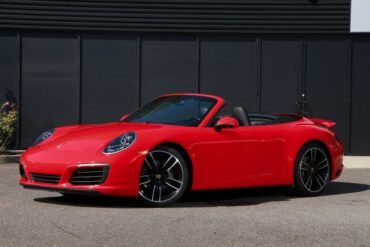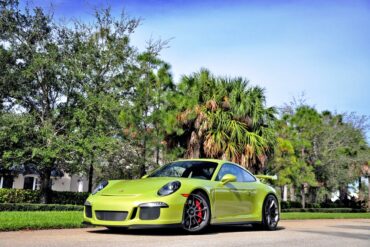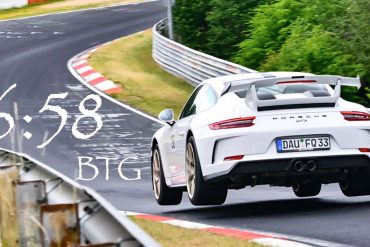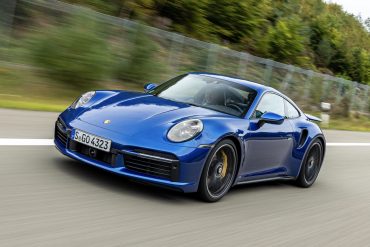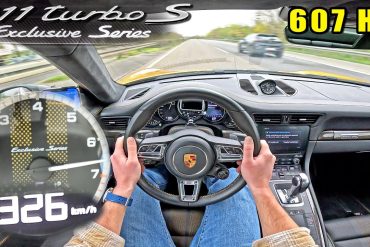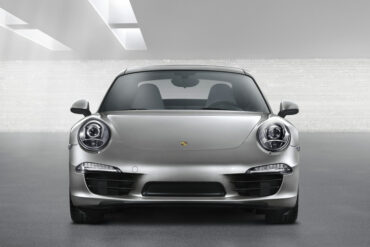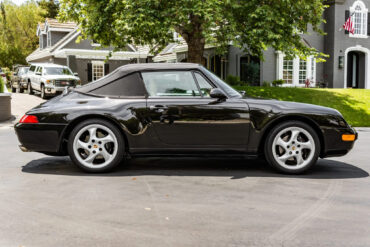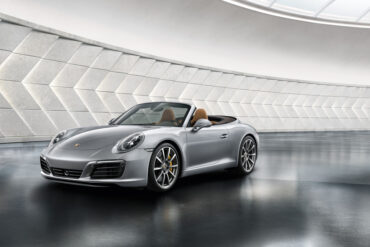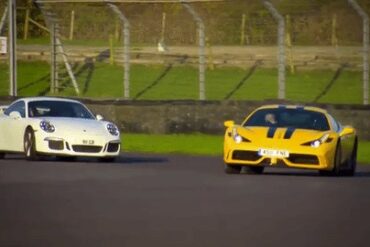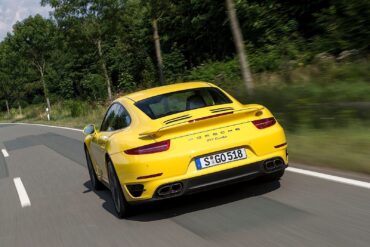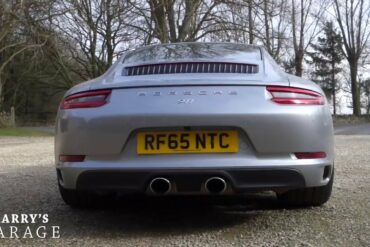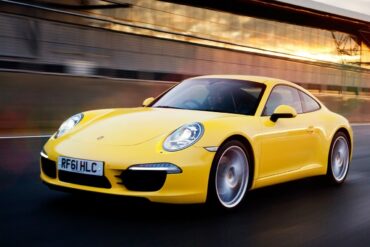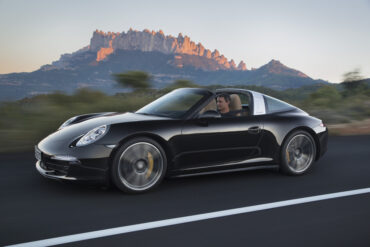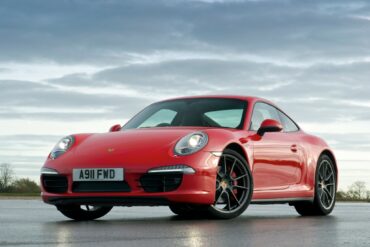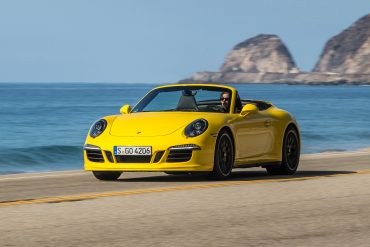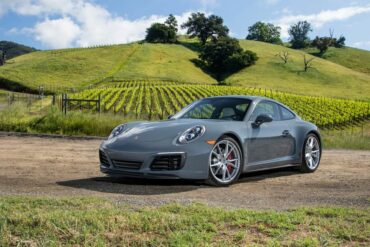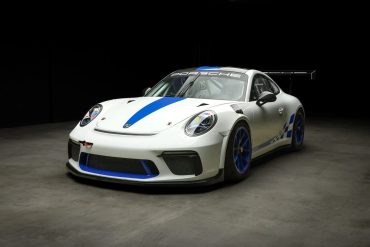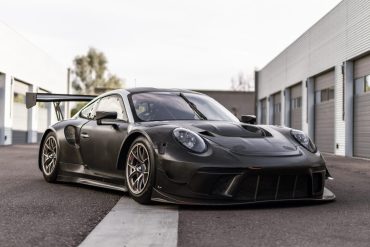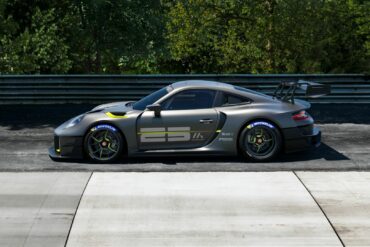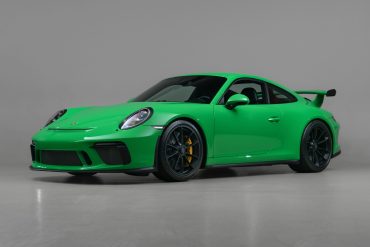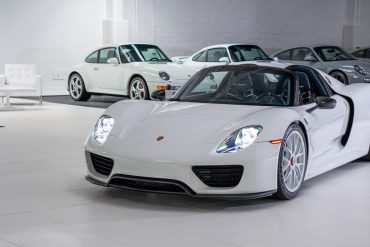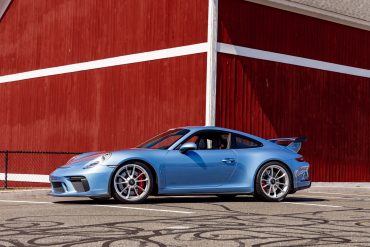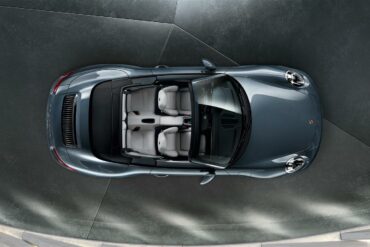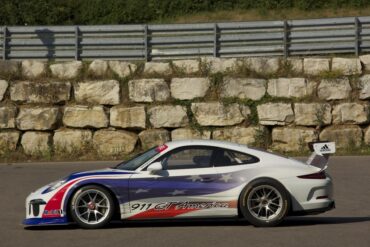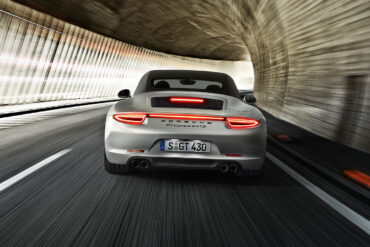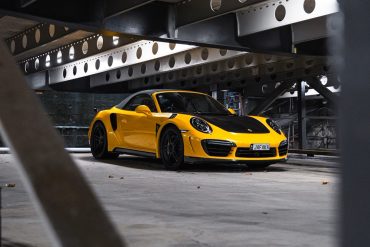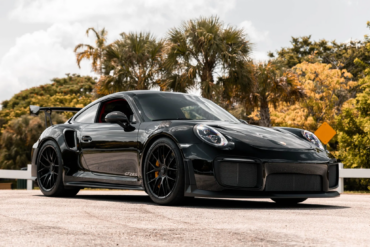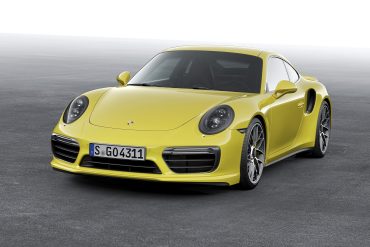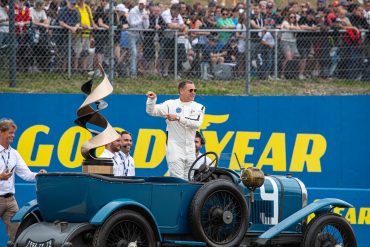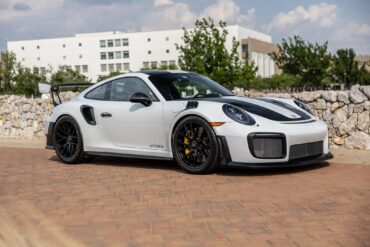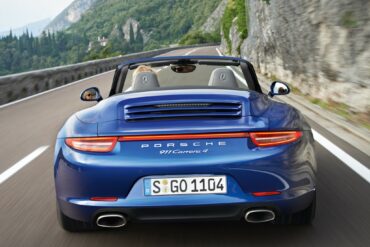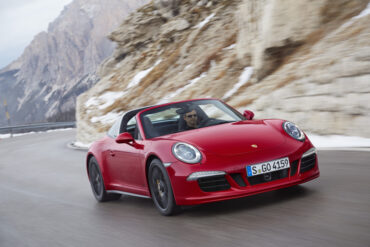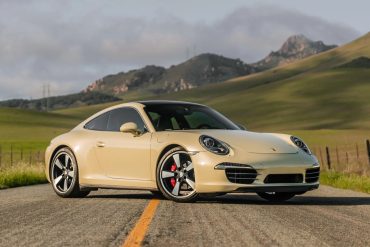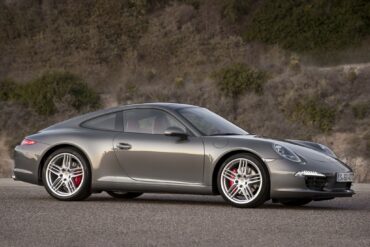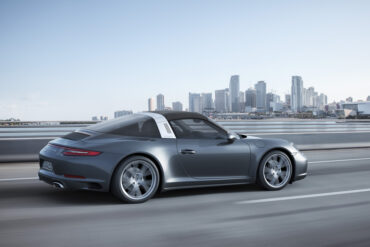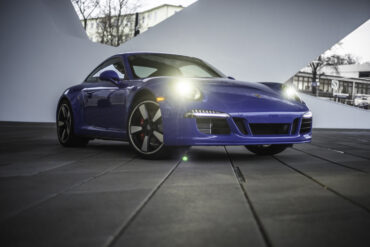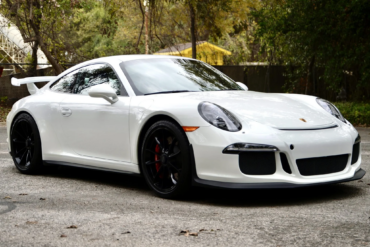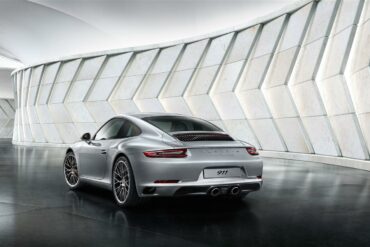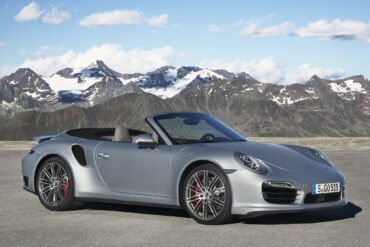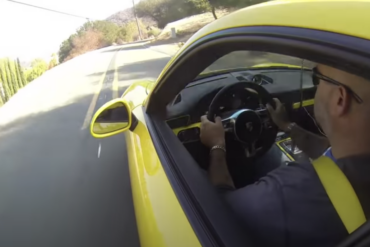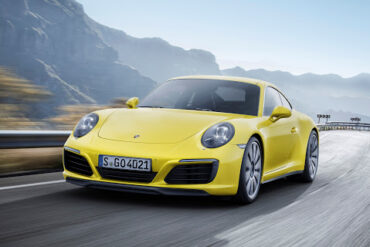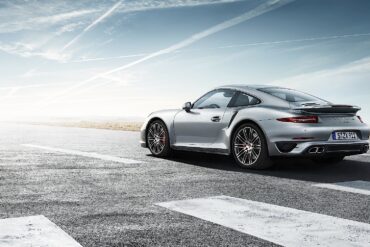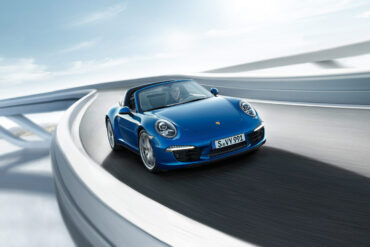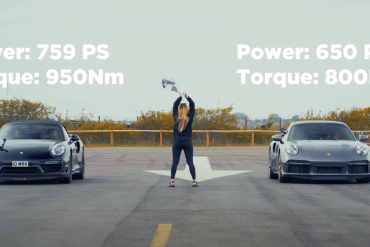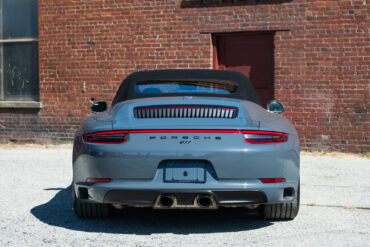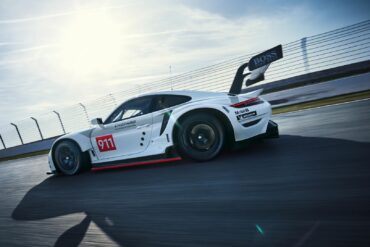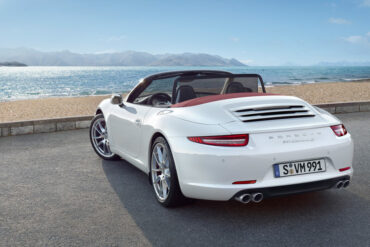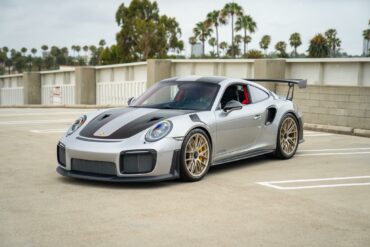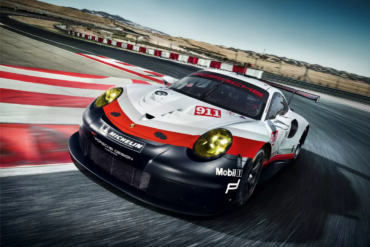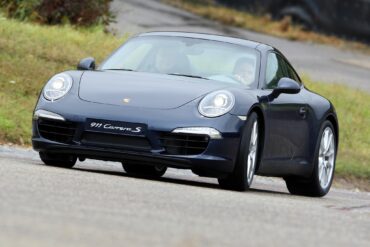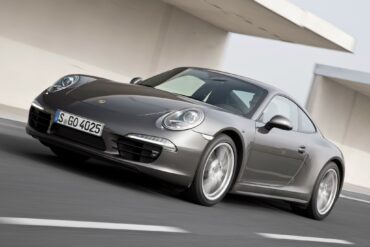The new all-wheel drive 911 is being launched on the market in four versions – as the 911 Carrera 4 and 911 Carrera 4S and each as Coupé and Cabriolet. The Coupé and Cabriolet of the 911 Carrera 4 S each have a 3.8-litre rear-mounted boxer engine that produces 400 hp (294 kW); this enables acceleration to 100 km/h in 4.1 seconds (Cabriolet: 4.3 seconds) and a top speed of 299 km/h (Cabriolet: 296 km/h) with a suitable equipment configuration. Fuel consumption values with PDK are 9.1 l/100 km (CO2 215 g/km) for the Coupé and 9.2 l/100 km (CO2 217 g/km) for the Cabriolet.
Porsche 911 (991)
The Type 991 911 series was the seventh generation of the iconic 911. The 991 generation models were unmistakably 911 in looks and design philosophy, but the 991 was really the ultimate evolution of Porsche 911s becoming highly technical, high quality and well built machines. Quality improved and the technology jump finally vaulted Porsche to the top of the automakers in terms of building the best cars on the planet. The Type 991 represented the most technically advanced 911 model to date and the 991 looked more powerful than any other 911 before – an effect that was heightened by the wider track and a stretched wheelbase. It also featured adaptive aerodynamics: the 911 was the first series sports car from Porsche to adopt this technology from the 918 Spyder hybrid super sports car. The 991.1 generation cars launched as MY 2012 cars. The 345hp 3.4 liter Carrera and 400hp 3.8 liter Carrera S launched first, in both Coupe and Cabriolet bodystyles and could be had with either rear and all-wheel drive drivetrains. The 991s all got electric power steering which took away some of the feel we were used to. The Carrera S got PASM standard (optional on the Carrera). The new Turbo (in coupe and cabriolet) came out in 2013, now with a whopping 512hp. See all of our Porsche 991 Research.
Everyday Driver compares and contrasts the Porsche 911 Carrera 4S and the BMW M240i. Guess which car comes out on...
2016 – 2019 Porsche 911 Carrera 4 Cabriolet (991.2) Pictures & Gallery...
Porsche introduced the 991 GT3 for the 2014 model year, as follow up to the multiple 997 GT3 variants. The...
Porsche answered the calls of their faithful fans and as a result they designed the 2016 Porsche 911 R with the...
Automatic transmissions are now the standard option for cars. They are very efficient and convenient not just for everyday use...
Top Speed In a Porsche 911 GTS German correspondent Thomas Hellmanzik gets his first 911 driving experience, and promptly hits...
2019 Porsche 911 Carrera S Coupe (991.2) Technical Specifications Engine Engine layout Rear Engine Engine type Boxer, twin-turbo Cylinders 6 Valves...
To date, 27 different variants make up the current generation of the 911 model line-up. Chatting to its developers at...
With a limited production of just 500 units worldwide, the 991.2-generation Porsche 911 Turbo S Exclusive Series lives up to its new...
2019 – 2020 Porsche 911 GT3 R (991.1) Pictures & Gallery...
2019 Porsche 911 Carrera 4 Cabriolet (991.2) Technical Specifications Engine layout Rear Engine Engine type Boxer, twin-turbo Cylinders 6 Valves per...
2012 – 2015 Porsche 911 Carrera Pictures & Gallery...
The Porsche 911 is a legendary car, revered for its timeless design, exceptional performance, and exhilarating driving experience. It also...
Bring A Trailer is currently offering three interesting low mileage Porches that will surely catch your interest. 1998 Porsche 911...
At the FIA World Endurance Championship WEC, two 911 RSR by the Porsche GT Team will be saying farewell to...
The switch to turbocharging delivers predictably faster acceleration, with 0 - 60 mph taking just 3.9 seconds with the PDK transmission and Sport Chrono optioned. The quarter mile is dispatched in 12.2 seconds and the top speed for the open top Carrera S is 190 mph. These numbers are pretty impressive for an open top 911 that is just as comfortable driving around town as it is on back roads on spirited runs. With the 991.2 Carrera S Cab, it can be argued that there is no real need dynamically to opt for. the coupe body. A great overall sports car that is fast, fun and happens to have no roof.
Vehicle Virgins just released a review on the manual Porsche 911 GT3 RS. Make sure to listen to the last...
This video shows a head to head battle between the two of the best cars on the market today: the 458...
2016 Porsche 911 Turbo (991) Technical Specifications Engine layout Rear Engine Engine type Twin Turbo Boxer w/ VTG Cylinders 6 Valves...
2015 Porsche 911 GT3 (991) Technical Specifications type Series Production Car released at 2013 Geneva Motor Show built at Stuttgart, Germany...
Collecting Cars is proud to offer this limited edition and almost new 2019 Porsche 935. The 935 tribute car was...
Our guys from PCarMarket is currently offering a 2017 Porsche 991.2 Turbo S with the Aerokit package. It is finished...
Harry’s Garage 991.2 Carrera S Review The new 911 991.2 Carrera S is powered by a new twin-turbo 3.0 litre...
2013 Porsche 911 Carrera S Coupe (991) Technical Specifications Engine Type Flat 6 Induction Normally-aspirated Cooling Water-cooled Valvetrain Four overhead camshafts,...
This is the open-top model for those who don’t want the full convertible experience – and it’s only available in the wide-hipped four-wheel drive bodyshell. The new Targa is a striking design, echoing the 1965 original with its fixed rollover bar. The Targa 4S, gets you the more powerful 3.8 engine from the Carrera S. It mixes regular Carrera 4S go with a sense of style and everyday usability (those occasional rear seats, the real possibility of 30mpg in everyday driving). Great car.
Check out this really incredible review on a heavily modded 2015 Porsche 911 Turbo S 991.1 with upgraded turbochargers and...
2013 – 2015 Porsche 911 Carrera 4S Pictures & Gallery ...
The 2015 Porsche 911 Turbo S coupe, finished in Jet Black Metallic, has been equipped with a Gemballa GT Concepts...
2018 Porsche 911 Targa 4S (991.2) Technical Specifications Engine Engine layout Rear Engine Engine type Boxer, twin-turbo Cylinders 6 Valves per...
2016 Porsche 911 Carrera GTS Cabriolet (991) Technical Specifications Engine layout Rear Engine Engine type Boxer-6 Cylinders 6 Valves per...
2019 Porsche 911 GT3 (991.2) Technical Specifications Engine Engine Type Aluminium horizontally opposed and naturally aspirated engine Cylinders 6 Displacement 3,996...
POV Tearing Up a Mountain in a 991 GT3 RS One of our favorite POV videos so far, this takes...
Porsche 991 GT3 RS on road and track Looks like a 911, drives like a hypercar? The Porsche 911 GT2...
2018-2019 Porsche 911 GT2 RS Clubsport Race Version (991.2) Technical Specifications Concept Single-seater near-standard non-road-homologated race car Basis Porsche 911...
2017 Porsche 911 Carrera 4S (991.2) Technical Specifications Engine layout Rear Engine Engine type Boxer, twin-turbo Cylinders 6 Valves per cylinder...
In a recent video shared by AutoTopNL on YouTube, we get to see a Porsche 991.2 Turbo S gets pushed...
Built as the second example in a limited production series of only five units for the year 2018, this GT3...
Porsche officially unveiled the 991 GT2 RS at the 2017 Goodwood Festival of Speed. This model boasts a carbon-fiber reinforced...
Based on the 911 GT3 RS production sports car, Porsche has designed a customer sport race car for GT3 series...
2021 Porsche 911 GT2 RS Clubsport 25 Pictures & Gallery...
2019 Porsche 911 Targa 4 GTS (991.2) Technical Specifications Engine Engine layout Rear Engine Engine type Boxer, twin-turbo Cylinders 6 Valves...
The 991.2 generation of Porsche’s 911 GT3 marked a significant improvement over its predecessor, incorporating several desirable changes. Responding to...
You already read about our preview of The White Collection auction here on Stuttcars. Fifty-five Porsches, mostly in white, with...
This 2018 Porsche 911 GT3 has a 4.0-liter flat-six engine coupled with a seven-speed PDK dual-clutch transaxle, and features a...
2018 Porsche 911 Carrera Cabriolet (991.2) Technical Specifications Engine Engine layout Rear Engine Engine type Boxer, twin-turbo Cylinders 6 Valves per...
The 911 GT America was based on the 991 GT3 Cup. It was built exclusively for the United Sports Car Racing (USRC) series and its GT Daytona class for 2014. While the GT3 Cup had a 3.8-litre engine at the time, the GT America was fitted with a 4.0-litre unit developing 351 kW. The main visual difference is the rear spoiler made to fit the USRC rules. Like the GT3 Cup, the GT America has 380 mm steel brake rotors at the front axle with 6-piston fixed calipers.
2016 Porsche 911 Carrera 4 GTS Cabriolet (991) Technical Specifications Engine layout Rear Engine Engine type Boxer-6 Cylinders 6 Valves...
The Porsche 991.2 Turbo S Cabriolet is a top-of-the-line convertible with a hefty price tag of $200,400. This powerhouse offered...
The 991-generation GT2 RS has been called as the pinnacle of the German automaker’s lineup of high-performance road cars. Only...
One of the BEST Sportscars Money Can Buy We go for a drive in the 2018 Porsche 911 GT3. Our...
2017 – 2019 Porsche 911 Turbo S (991.2) Pictures & Gallery ...
Epic Drag Race It’s time for an EPIC drag race! We’ve got three tuned cars going head-to-head over the quarter...
Henry Catchpole drives the 991.2 Porsche 911 GT3 RS in search of the forgotten Sudschleife circuit....
All Images by: Virtual Motorpix/Glen Smale and Corporate Archives Porsche AG In the 2023 Le Mans 24 Hour race, the...
The debut of the Porsche 911 GT2 RS took place during the 997 generation in 2010 and received exceptional acclaim....
2015 Porsche 911 Carrera 4 Cabriolet (991) Technical Specifications Engine Type Flat 6 Induction Normally-aspirated Cooling Water-cooled Valvetrain Four overhead camshafts,...
The Targa 4 GTS gets Porsche’s a powerful non-turbo rear-mounted flat-six engine with 430 bhp @ 7500 rpm and 325 ft lbs of torque from 5750 rpm, driven to all four wheels via Porsche Traction Management. Performance is also enhanced via the standard Sport Chrono package, which provides faster throttle response and more aggressive shift mapping. In addition, the GTS benefits from Porsche Active Suspension Management - Porsche’s proprietary adaptive suspension system with continuously variable dampers. Mechanically, this is the perfect package for a daily 911 that is also performance focused when you need it to be.
The 2014 50th Anniversary Edition 911 was built by Porsche to commemorate the 911’s birthday, 50 years after its production...
Simply put, the newest Porsche 911 GT3 RS is designed to give maximum performance on and off the track. Porsche...
2015 Porsche 911 Carrera Coupe (991) Technical Specifications Engine Type Flat 6 Induction Normally-aspirated Cooling Water-cooled Valvetrain Four overhead camshafts, four...
Bring A Trailer is currently offering a low mileage and eye-catching example of Porsche’s 991.2 generation track-focused supercar that also...
Carfection Reviews the New 991.2 Carrera S Porsche’s gone turbo on the 2016 911 Carrera S, so we thought it...
The 991.2 Targa did get some mild design changes, but they are all inline with the rest of the 991.2 changes. Despite the mild styling revisions, it’s a dramatically different car in terms of its engine. The iconic and highly regarded naturally aspirated 3.4-litre flat-six engine has been ousted for a more environmentally friendly twin-turbocharged 3.0-litre. It keeps its all-wheel drive system and is still an all-weather 911. A sports car with all-wheel drive is the first choice for more than one in three Porsche 911 buyers. It is sporty and comfortable, the turbo engines more powerful and consume less, with the improved all-wheel drive.
Here we have a battle between two German sports cars: a 991.2-generation Porsche 911 Turbo S with a whooping 900...
The 991 Porsche Turbo is a practical and reliable daily driver with supercar performance. It’s certainly a car that many...
Does the turbocharged 911 move the game on enough? After a mammoth road test in issue 137, Total 911 decide...
To celebrate 60 years of Porsche Club of America, PCNA (Porsche Cars North America) ordered 60 units of 911 Carrera GTS Coupés in Club Blue from Porsche Exclusive. All 60 cars were equipped with SportDesign aerokit (including ducktail). These Club cars were not numbered because it wasn't a special series by Porsche AG, but a series of similarly equipped cars ordered by PCNA. The cars got a few unique touches by Porsche Exclusive, like the special "Club Blau" paint, the "Club Coupe" stickers on the doors, the door entry guards with ''GTS Club Coupe" lettering and number "60" embossed on the armrest cover.
TheGetawayer Reviews the 991.1 GT3 I finally review the new 2014 Porsche 911 GT3 (991). Can it match the driving...
In the 50th anniversary year of the 911, Porsche opened a new chapter in race track performance sports cars. The...
2018 Porsche 911 Carrera S Coupe (991.2) Technical Specifications Engine Engine layout Rear Engine Engine type Boxer, twin-turbo Cylinders 6 Valves...
2016 Porsche 911 Turbo Cabriolet (991) Technical Specifications Engine layout Rear Engine Engine type Twin Turbo Boxer w/ VTG Cylinders 6...
2017 – 2019 Porsche 911 Carrera 4 GTS (991.2) Pictures & Gallery...
The Porsche 911 GT2 RS made its debut during the 997 generation in 2010, receiving immense praise. The 991-generation GT2...
TheSmokingTire Review of the 991 Porsche 911 Carrera S Matt takes a spirited drive through the canyons in the 2014...
Old vs New GT3 Showdown Great hands-on review and comparison between two of our favorite 911s. A Porsche 911 992...
Porsche Option Codes – Porsche 911 (2017 Model Year) Looking to decode your 2017 Porsche 911 option codes? Want to...
Porsche 911 Turbo & Turbo S (991.1) Technical Specs & Performance Here year is year of introduction, not model year....
2014 – 2015 Porsche 911 Targa 4 Pictures & Gallery ...
In today’s video we watch a 992 Turbo S up against a tuned 991.2 Turbo S....
A Thorough Review of the 991.2 GT3 RS The 991.2 GT3 Rs comes with a power upgrade to the 911...
2018 Porsche 911 Carrera 4 Cabriolet (991.2) Technical Specifications Engine layout Rear Engine Engine type Boxer, twin-turbo Cylinders 6 Valves per...
Porsche 911 RSR (991.2) (2019-2021) – Pictures & Gallery...
2015 Porsche 911 Carrera S Cabriolet (991) Technical Specifications Engine Type Flat 6 Induction Normally-aspirated Cooling Water-cooled Valvetrain Four overhead camshafts,...
We’ve got some good news for you, as we’ve found a bargain for a Porsche! Currently, a 2018 Porsche 991...
Turbo supercars fight it out The Ferrari 488 GTB is the first turbocharged, mid-engine Ferrari since the legendary F40 in...
Sporty, stylish, and a super-fast all-weather grand tourer is how would you like to best describe this 2015 Porsche 911...
Two decades after the different 911 GT1 cars the mid-engined 911 is back! In order to install a proper diffuser under the rear end of the 991, the engine had to make room for it and the engine/transmission unit was rotated 180 degrees. The extended rear diffuser, a top-suspended rear wing and the new side mirrors help to increase downforce with reduced drag. The FIA rules meant no turbo was needed due to power limits, so the normally aspirated 4-litre flat-6 was taken from the 991 GT3 R.
Porsche 911 GT3 RS Screaming 9,000 RPM Flat Six Special Thanks to Boston Motorsports for this incredible drive in the...
2015 Porsche 911 Carrera S Coupe (991) Technical Specifications Engine Type Flat 6 Induction Normally-aspirated Cooling Water-cooled Valvetrain Four overhead camshafts,...
2016 Porsche 911 R (991) Technical Specifications Engine layout Rear Engine Engine type Boxer Cylinders 6 Valves per cylinder 4 Construction...
2013 – 2015 Porsche 911 Carrera 4 Pictures & Gallery ...
No More Content




